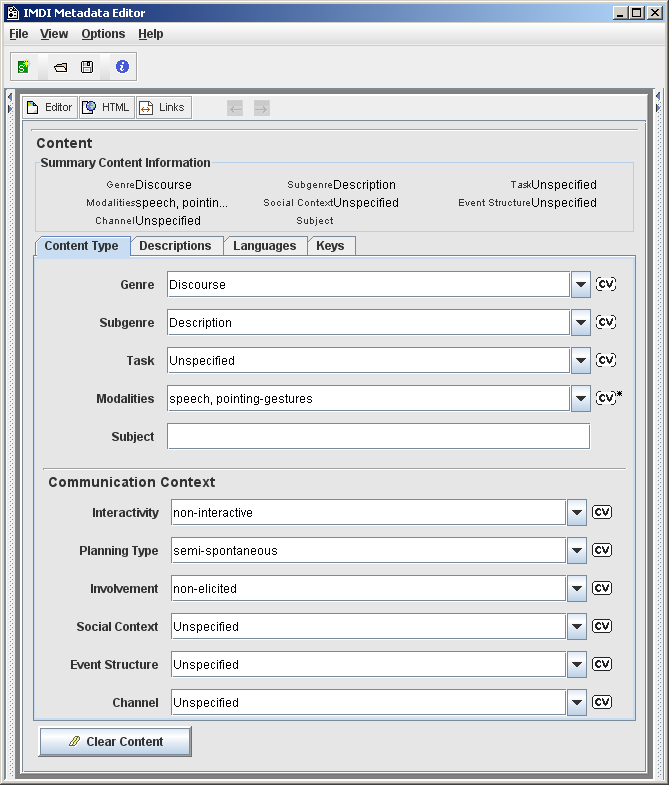Information about the genre, the task, the modalities, the subject, and the communication context. For example:
Many of the fields under Content Type offer predefined values that are displayed in the form of pull-down menus[3]: some of them only accept values from the pull-down menu, while others allow you to enter alternative values (see below). Furthermore, it is sometimes possible to enter more than one value – in this case, please separate the values with a comma. See Section 1.5.2 for the different options and how they are symbolized in the IMDI Editor.
Genre and Subgenre
Information about the genre and the subgenre, whereby Subgenre is dependent on Genre. I.e., the value that you enter under Genre will determine the values that are available under Subgenre. Both Genre and Subgenre are 'open vocabularies', i.e., you do not have to select a value from the pull-down menu, but can enter an alternative value instead. The following values have been suggested:
Genre
Subgenre (Example)
(a folktale, a historical narrative, a personal experience narrative)
(a summing-up speech by a legal counsel, a political speech, a church sermon)
(a recipe, an instruction on how to build a house)
(proverbs, greetings/leavetakings)
Play (riddles, humor)
(a description of the layout of a compound)
(a prayer, a healing ritual, a catechism)
(a detective novel, a science fiction story)
(a political essay, a scientific report)
(a political discussion on the radio, a documentary on animal life on the TV)
(a psalm, a slogan during a demonstration)
(a ballad, an oral epic)
(a short novel, a tragedy)
(a picture book elicitation, a story retelling, a matching game)
![[Note]](images/note.png) | Note |
|---|---|
If there are several Subgenres, you can enter all of them into the Subgenre field. Separate them with a comma. |
Task
The name of the experimental or stimuli-based task that was carried out (if any). Choose a value from the pull-down menu (e.g. info-kiosk, wizard-of-oz, travel-planning, room reservation, or frog story), or type in an alternative value.
Modalities
The modalities under investigation. Choose a value from the pull-down menu (e.g., speech, writing, gestures, pointing-gestures, signs, eye-gaze, facial-expressions, emotional-state, haptic), or type in an alternative value.
Subject
The subject(s) or topic(s) of the session. There are no constraints on this field.
Communication Context
Information about the communication context, i.e., levels of participant interaction, the degree of planning through the speaker(s), the involvement of the researcher(s), the social context, the event structure, and the channel. All six are 'closed vocabularies', i.e., a value from the pull-down menu must be chosen – other values will not be accepted. Enter the following information:
Interactivity
The level of participant interaction, i.e.:
value comments an interaction between at least two participants. It may or may not include an investigator, e.g.: conversation
many narratives
matching game
a monologue, produced without expecting extended verbal responses from the hearer(s), e.g.: many oratory texts and songs
some narratives
primarily a monologue, but punctuated by repeated interjections from the hearer(s), e.g.: a child interrupting a narrative
hearer(s) repeatedly prompting a narrator
Planning Type
The degree of planning through the consultant, i.e.:
value comments an unprompted speech whose topic is not determined by the investigator or an observer, e.g.: conversation
chatting
joke-telling
singing while harvesting
a prompted speech whose topic is determined in some way by an investigator or a community member, but whose participants speak freely within this context, e.g.: interview
queries (e.g., ‘Tell me about the history of your village.’ ‘Show me how to make tortillas.’)
retellings (e.g., the speaker is asked to re-tell a story from a picture book, or to describe a task in his/her own words)
promptings (e.g., children answering a teacher’s questions)
the structure and content of the speech is planned in advance by the consultant/performer, e.g.: political or ritual speech
poem recitation
![[Note]](images/note.png)
Note This entry does not (necessarily) refer to an elicitation session, where a consultant is given a framework but does not plan his/her answer.
Involvement
The involvement of the researcher, i.e.:
value comments the investigator asks the speaker(s) to produce isolated phonemes, words, utterances or grammatical structures, e.g.: production of sounds in different phonological environments
responses to (morphological, lexical, etc.) questionnaires
the investigator does not interfere verbally with the speech event (other than with his presence) no outside observer is present (only a tape recorder) Social Context
The social context of the event, i.e.:
value comments Event Structure
The event structure, i.e.:
value comments Channel
The channel of communication, i.e.:
value comments
[3] Please see the document IMDI Metadata Elements for Session Descriptions under http://www.mpi.nl/IMDI/ for updated lists of values and their definitions.
